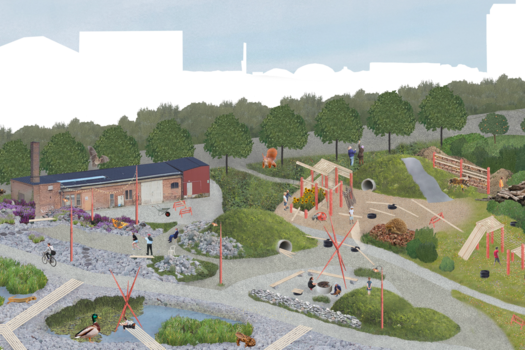Landscapes of Encounters
Västerås (SE) - Runner-up

TEAM DATA
Associates: Marcus Andersson (SE), Mats Andersson (SE), Matilda Hansson Jessen (SE), Klara Wahlstedt (SE) – architects
Studio Träda
+46 736879838
trada.arkitektur@gmail.com / /studiotrada
See the complete listing of portraits here
See the site here
TEAM PORTRAIT
VIDEO (by the team)
INTERVIEW
Click on the images to enlarge
1. How did you form the team for the competition?
We all did our master in architecture at Chalmers University of Technology and during this time we found that we were interested in similar topics. After our degree we figured it would be interesting to work together and continue our discussions. The theme of Europan16 – Living Cities, was a great opportunity to try out our thoughts within a real situation.
2. How do you define the main issue of your project, and how did you answer on this session main topic, Living cities?
We see a living city as a place that should support a variety of inhabitants, both humans and non-humans. To create a multispecies city we have to accept other species as social beings and acknowledge their agencies. It’s about showing curiosity towards other ways of living. Thereby a living city can never be a monospecies city, it’s a landscape of encounters. To act as designers in this kind of process calls for us to be present in the different negotiations that’s going on between species, it’s about learning when to be in control and when to leave the initiative to others. In the end it’s about becoming aware that we are coexisting in world-making.



Today the site in Västerås is dominated by industrial areas. At first glance it’s an uninviting area for humans to engage with, but the lack of care for one species could be an invitation for another. Like the hares jumping through the bushwoods near the train tracks, the birds feeding on the leftover grains from the silo or the peregrine falcon inhabiting the cliff-like roof. Our focus has been to enhance such qualities and propose strategies for announcing presence, making additions and invitations to be able to perceive and inhabit the site in new ways. Creating new stories of what the city can become if we allow it.



We have all taken interest in these kinds of questions before. In our individual master theses from last year we expanded on the topic in different ways. Literature that guided us back then came from authors like Donna Haraway, Francesco Careri, Anna Tsing among others. For our Europan proposal we also found inspiration from projects such as Ducklands (Cedric Price Architects), Grasslands (Linda Tegg), The voice of children (Assemble Studio).



In our proposal we consider architecture as a guiding practice that could be used to curate the messiness found in the area. The brief from the municipality in Västerås is interesting because it highlights a window in time between two economic and productive periods of the site – its previous role as an industrial area and the future residential exploitation. This offers possibilities for new approaches to rethink what kind of lives the city can host. The brief asks for temporary architecture, and our answer is to work with small scaled structures and initiatives, processes of trial and error. This demands that we as architects are involved along the way and continuously curate the transition of the site, having an ongoing dialogue with the municipality and the (human and non-human) citizens. To be present at the site also makes it easier to manage reused materials. By letting the site accumulate and consider material, engagements and relations over time, it can become a foundation for co-creational processes by the citizens. Here architecture is not a finished product, but rather a world-making collaboration, a companion that initiates open-ended processes that could be claimed by the multispecies citizens.
6. Is it the first time you have been awarded a prize at Europan? How could this help you in your professional career?
Yes, this is our first participation in Europan. To receive this recognition gives us credibility to make way for discussions on the subject. It is encouraging to see that the other awarded proposals in Västerås were touching upon similar questions, that there is an emerging attention towards these kinds of approaches. We hope that this can be a platform for us to develop further discussions.
TEAM IDENTITY
Office: Studio Träda
Function: architecture
Average age of the associates: 29 years old








